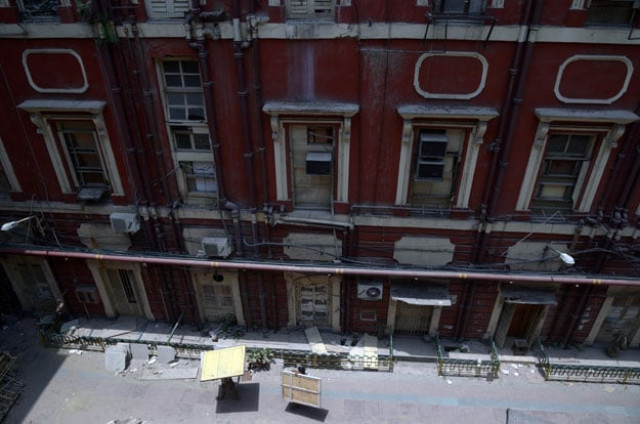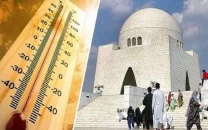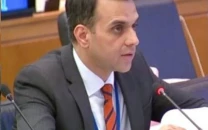Kolkata's Writers' Building refit plagued by problems
It dates back to 1776 when Hastings commissioned Lyon to construct building for East India Company's legions of...

Indian labourers undertake renovation work on the Writers' Building in Kolkata. PHOTO: AFP
"We even wrote to the British Library in the hope that some of the drawings might have been preserved there," says architect Madhumita Roy as she talks through some of the problems her team has faced trying to restore one of India's most iconic buildings to its original glory.
"They were able to provide photographs of the building's facade from the early 1880s but they said that copies of the original plan were not available," she told AFP.
 Indian labourers undertake renovation work on the Writers' Building in Kolkata. PHOTO: AFP
Indian labourers undertake renovation work on the Writers' Building in Kolkata. PHOTO: AFP"And when we had almost given up hope, these three drawings surfaced in our public works department under volumes of drawing plans for various other buildings in the city."
The discovery was a rare piece of good news in a project that is more than a year behind schedule and has drawn widespread criticism in the eastern metropolis of Kolkata.
Read: Controversy: Indian vice president not invited to Yoga Day celebration in Delhi
The red-brick complex dates back to 1776 when Warren Hastings, the first governor general of British-run India, commissioned Thomas Lyon to construct a building that would serve as the offices and living quarters for the East India Company's legions of clerks, known as writers.
 PHOTO: AFP
PHOTO: AFPThe East India Company was the de facto ruler of India until a revolt in the ranks of its private army in 1857. The writers stationed in what was then India's capital shaped the lives of tens of millions.
Over the years, a host of extra wings and adornments were added, including the Greek-style statues of goddesses on the roof which symbolise everything from justice to agriculture.
Although the British shifted the capital from Calcutta (now called Kolkata) to New Delhi in 1911, the building known simply as Writers' continued to serve as the administrative headquarters of the massive state of Bengal.
It enjoyed a new lease of life after India gained independence in 1947 as home to the government of the state of West Bengal but slowly fell into disrepair and was blighted by several fires.
 PHOTO: AFP
PHOTO: AFPWhen current Chief Minister Mamata Banerjee ordered a $30 million refit in 2013, work was only supposed to take around six months.
The aim was to revamp the interior, prune the building of later additions and restore courtyards which had been used as carparks or dumping grounds to their former glory.
Read: Pakistan, India to operate banks across border soon: Mansha
Banerjee and her government relocated in October 2013 to a nondescript office block on the other side of river Hooghly in the twin city of Howrah, expecting to be back in Writers' within the year.
 PHOTO: AFP
PHOTO: AFPBut the process of clearing the building — home to around three dozen different departments — took many months more than anticipated.
And while some work was able to start last year, Roy, who heads the architecture department in the city's Jadavpur University, said the quest to find the original masterplan caused major delays.
The documents were finally unearthed in May this year in the public works department, one of a handful of offices to have stayed put.
But the project soon encountered more turbulence when civic groups recoiled at the plans to demolish the newer wings.
 PHOTO: AFP
PHOTO: AFP"We have decided to keep the main building and all the five blocks intact since they are part of the heritage structure, but we will raze all the other eight blocks which have been built in the post-independence era," explained Roy during a tour of the renovation work.
Read: Muslim pilot in India appointed guardian of orphaned Hindu children
When notices were posted last month stating "this block/building will be demolished", there was an immediate backlash.
Anger intensified when bulldozers began reducing part of the structure to rubble, a move campaigners say lacked approval from the city's conservation watchdog.
 PHOTO: AFP
PHOTO: AFP"Writers' is listed with the civic body as a Grade I heritage structure," said Subrata Sil, director of the city's Heritage Conservation Committee.
"The state public works department did not seek prior permission for carrying out renovation or alteration work," he told AFP.
Surya Kanta Mishra, leader of the state's main opposition Communist party, said the "renovation plan is flawed" and made no mention of what it intended to do with some of the building's key features.
 PHOTO: AFP
PHOTO: AFPWest Bengal urban development minister Firhad Hakim insisted the work would be handled sensitively.
"Writers' is one of British India's earliest, grandest and most important structures. Its restoration is a challenge to our government."
Roy agreed that the sensitive nature of the work meant that it would be some years yet before bureaucrats could move back in.
"Opposition from some quarters has slowed down the work but we are determined to restore the glory of this iconic heritage structure," Hakim said.



















COMMENTS
Comments are moderated and generally will be posted if they are on-topic and not abusive.
For more information, please see our Comments FAQ